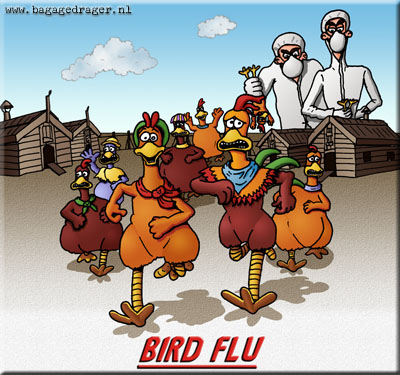The World Health Organization (WHO) announced on Tuesday that the H1N1 “swine flu” pandemic was officially over. The declaration came only about six months after virtually everybody else in the Western world realized that nothing like a pandemic, as we normally understand the term, had ever really begun.http://fullcomment.nationalpost.com/2010/08/11/kevin-libin-who-cancels-its-false-alarm/ Thirteen months ago, the WHO raised the swine flu threat to a Level 6 pandemic alert, the highest possible. “It is all of humanity that is under threat,” warned Margaret Chan, the WHO director-general. The organization projected millions of souls might be struck down by the virus; the WHO’s assistant director-general drew comparisons to the Spanish Flu, which had wiped out upwards of 20 million people by 1919.
Thirteen months ago, the WHO raised the swine flu threat to a Level 6 pandemic alert, the highest possible. “It is all of humanity that is under threat,” warned Margaret Chan, the WHO director-general. The organization projected millions of souls might be struck down by the virus; the WHO’s assistant director-general drew comparisons to the Spanish Flu, which had wiped out upwards of 20 million people by 1919. It quickly became apparent that H1N1 would be nothing like that. And never will be. The WHO says this is now just another “seasonal influenza.” As those bugs go, it appears a milder strain. More common varieties kill 250,000 to 500,000 people worldwide every year. The total confirmed death toll of the Great Swine Flu Pandemic: 18,000.
The world’s most authoritative body suddenly seems far less authoritative, particularly as it resists acknowledging unnecessarily triggering worldwide fear. “We have never had a moment’s doubt of whether this is a pandemic or not,” insisted one official recently.
But then, the agency looks at these things very differently than most people — many of whom surely have grave doubts about how the so-called Swine Flu pandemic was handled from the start.
The WHO, after all, considers all pandemics potential threats to humanity. Its scientists also have a distinct way of establishing a pandemic. Any virus that jumps from animals to human-to-human transmission “leading to community wide outbreaks” in two countries triggers warnings. In recent years, the organization stopped requiring “several, simultaneous epidemics worldwide with enormous numbers of deaths and illness”; now pandemics “can be either mild or severe.” To qualify, a virus, until 2008, needed to “shift,” and spawn subtypes. This criteria, too, was removed.
“Although this change seems subtle, it is a significant change, and is a potential problem with the new WHO pandemic definition,” cautioned an editorial in the British Medical Journal’s Clinical Evidence last year.
But the UN-run health body has hardly exercised caution in communicating such semantic technicalities. Instead, it has sounded the pandemic alarm loudly and dramatically. Dr. Chan says it was “pure good luck” H1N1 didn’t confound our vaccines and antiviral drugs and deliver widespread death. If that’s luck, then humanity is on some streak: in 2005, the WHO predicted 150 million dead from the H5N1 Avian Flu, though the confirmed toll never reached even 100; the Global Health Council anticipated the 2003 SARS outbreak wiping out 60 million lives, but the final tally ended up below 800.
In every case, people and economies have been more afflicted by contagious panic — closed borders, travel bans, shuttered schools and businesses, edgy consumers, mass livestock culls, and billions spent by taxpayers on protection programs — than by contagious disease.
This is not the concern of Dr. Chan, who has argued, anyway, that believing modern, liberalized trade improves living conditions and health worldwide is mistaken. Such systems “favour those who are already well off,” she told the Regional Committee for Europe, last September. Progress comes, rather, from redistribution: “Gaps in Health outcomes will be reduced, and health systems will strive for fairness only when equity is an explicit policy objective, also in sectors well beyond health,” she said. We need “changes in the functioning of the global economy.”
With that philosophy, it makes sense that Dr. Chan might mistake for “pure luck” what is more likely the fruit of progress, driven largely by liberalized commerce. WHO officials suggest devastating pandemics are inevitably cyclical: After the millions of deaths caused by the Spanish Flu, the Asian Flu (1957) and the Hong Kong Flu (1968), the next is due “any time now” they’ve promised. But in each subsequent pandemic, the world was a richer, better-fed, generally healthier place — and each time, mortality rates grew smaller.
Epidemiologists know influenza viruses prove deadliest in victims weakened by pre-existing complications. Since the Spanish Flu, public health is incalculably better: we’ve developed and commercialized sulfa drugs and penicillin; we’ve improved vaccines; malnutrition levels in the developing world are half what they were 40 years ago. The fact that H1N1 did not outfox human vaccines and anti-virals might seem lucky to those lacking faith that human enterprise and innovation can also prove ingeniously adaptable and potent.
It may be there will never be another decimating flu plague on the scale of past ones again.
Predictably, though, the WHO has only taken its massive Swine Flu misjudgment to warn against growing “complacent,” as another threat could one day come. But the false alarms have only bred doubt about the WHO’s own trustworthiness, popularizing theories that the agency colludes with Big Pharma while nourishing skeptics who convince the gullible that vaccinations are a dangerous scam. Even the Parliamentary Assembly of the Council of Europe called this a “faked pandemic.”
If we do ever become complacent about genuine viral pandemic threats, it may be the unfortunate result of the World Health Organization’s emerging pattern of needless panics.
CLICK HERE TO GO BACK TO MAIN PAGE................or HERE TO GO HOME






















